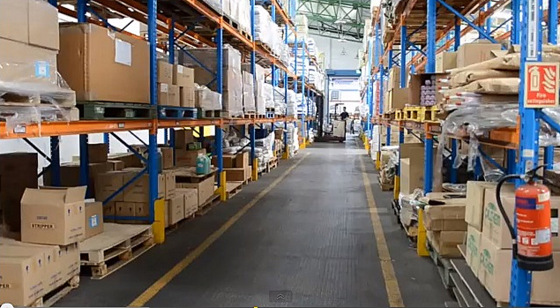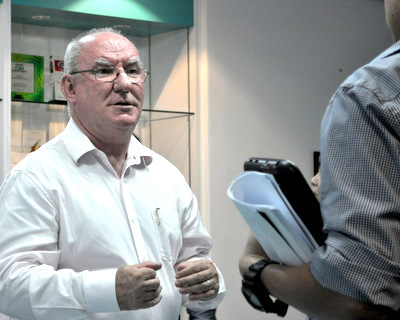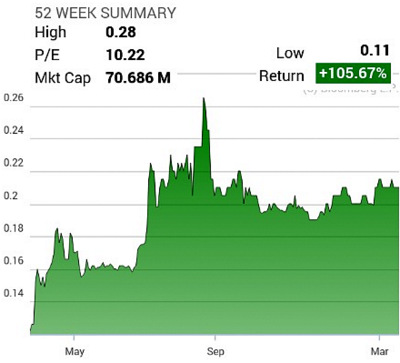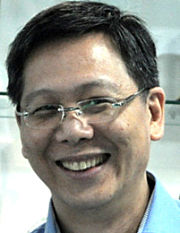SINWA LIMITED has delivered another piece of sweet news in the form of FY13 net profit attributable to shareholders being S$6.8 million in FY13 against a S$5.8 million loss in the previous year.
 Sinwa serves customers calling at more than 100 ports from its 12 offices in Singapore, China, Australia and Malaysia. NextInsight file photo of a Sinwa warehouse (above) Sinwa serves customers calling at more than 100 ports from its 12 offices in Singapore, China, Australia and Malaysia. NextInsight file photo of a Sinwa warehouse (above)
The FY13 results were devoid of items that dragged down FY12 results, including impairment losses on assets and operational losses from the chartering division and engineering division.
Last year, Sinwa divested most of its interest in the chartering and engineering businesses.
The strong profitability in FY13, thus, reflects the resilience of its core business in marine, offshore supply and logistics in the face of overcapacity and volatile freight rates in the shipping industry.
Revenue from these segments amounted to $140 million, up 15.6% y-o-y, while profit was S$7.2 million, up 22%.
Sinwa has proposed a 1-c final dividend, bringing its total bumper payout for 2013 to a record 4.5 cents a share, including special dividends.
The company had also recently announced the sale of the tug GO Emerald for a total consideration of US$5.5m (equivalent to $6.9m): USD4.2 m for the tug boat, USD1.3 m for termination and settlement of charter payment.
This gives rise to a S$1 million gain over book value, and will raise Sinwa's cash level to $31.6m from $24.7 m as at 31 Dec 2013, which far exceeds its S$8.7 m debt.
Investors expect that the balance sheet would be further strengthened when a court hearing resolves the fate of a seismic vessel, in which Sinwa holds a 50% stake, and leads to its disposal.
|
Here are some highlights from a Q&A session during the recent FY13 results' briefing.Q: Your core operations are in Singapore and Australia. What are your plans or progress for Thailand?
 Bruce Rann, CEO of Sinwa, fielding more questions after the FY13 results briefing. Photo by Leong Chan TeikCEO Bruce Rann:
Bruce Rann, CEO of Sinwa, fielding more questions after the FY13 results briefing. Photo by Leong Chan TeikCEO Bruce Rann: We are very cautious in investing into a foreign country due to the various risk factors that includes political, cultural and logistical. We have been in talks with Sodexo and we are continuing to assess this move.
Sodexo is operating at 21 oil rigs. We are still considering how we are going to operate over there, in terms of infrastructure and logistical matters.
With the oil and gas industry expanding so quickly in Thailand, we expect the demand for marine, offshore supply and logistical services to exceed the local supply, and we are optimistic that this trend, should Sinwa enter Thailand, will lead to inflow of business from MNCs such as Chevron, Seadrill, Noble and Transocean.
These MNCs want guaranteed, timely and quality supplies and services, and our market leading name and position place us in a sweet spot to tap on the growing demand.
Q: How much do you expect the capex to be in Thailand?
Bruce Rann: We do not see ourselves building any facilities and will be resorting to renting. We will remain cautious when it comes to investing in fixed assets and may revise this decision when we have entrenched ourselves there with a steady customer base. At this point in time, we are considering ways to keep our potential overheads low in order to maximise the profitability of our venture into Thailand.
Q: Are you servicing the mining industry in Australia?
Bruce Rann: No. However, we are continuing to grow in terms of servicing the marine & offshore industry in Australia, partially as a result of our working relationship with Sodexo here in Singapore. Sodexo and Sinwa share synergies and mutual benefits working with each other and we expect our working relationship to remain strong for many years to come.
Q: So is the marine and offshore industry contributing evenly to Sinwa’s revenue in Australia?
 Chart: Bloomberg
Chart: Bloomberg
Bruce Rann: The oil & gas industry contributes 85% of our revenue, with the remainder coming from blue water shipping.
However, this trend is reversed in Singapore as we are seeing increasing contribution from the oil & gas segment in Singapore as a result of the thriving offshore oil & gas industry in Asia Pacific.
Q: Could you shed some light on the revenue contributors in Australia and Singapore?
Bruce Rann: We are seeing about 70% revenue contribution from supplying of provisions while the rest comes mainly from supplying of technical stores. Interestingly, in the same order, Singapore is experiencing 60% and 40% contribution.
Q: Are you planning to move into any other regions or countries?
Bruce Rann: Even though we are seeing demand from our existing clients to provide our services in ports where we do not have a presence in, we do not wish to rush into reckless expansion for the reasons mentioned earlier regarding the complexities involved in moving into foreign areas.
We can appoint agents in representing us but at the same time, we want to remain consistent in providing timely and quality services. For this reason, we need to remain prudent when it comes to making these decisions.
Q: How much of your business comes from recurring customers? Also, what contributes to the growth in revenue for the core marine, offshore supply and logistics business?
Bruce Rann: As a result of our reliable services over decades, the majority of our businesses, at least 75%, comes from our regular clients. We are proud to be able to retain the bulk of our clients as a result of our top-notch services and this is further made possible as a result of long working relationship which enables us to know our clients’ preferences extremely well
.
Q: Sinwa saw a decline in profit margins over the last few years. What is the reason?
Bruce Rann: Our margins dipped as a result of two main factors. Firstly, it used to be higher as a result of contribution from the high-margin chartering segment which is mostly divested now.
Secondly, we experienced a disproportionate increase in demand for the supply of provision goods compared to technical stores. Supplying technical stores provides higher margin contribution.
We are reviewing our operations and in discussion with our suppliers in order to improve profitability.
We are also looking to expand our warehouse in view of our existing warehouses reaching their capacity. In addition to increased operational capacity, we expect the new warehouse to provide us with cost benefits as we will be able to import our provisions ourselves and in larger bulk.
Q: What are the growth limits for Sinwa?
 Introducing Sinwa's CFO-designate, Ng Hsian Pin, who joined the company in Oct 2013.
Introducing Sinwa's CFO-designate, Ng Hsian Pin, who joined the company in Oct 2013.
Photo by Leong Chan Teik
Bruce Rann: I do not expect any limitations as we can easily scale up our operations with our experience and expertise. The external growth factors, such as economic conditions and shipping industry downturn, may limit our growth but Sinwa has always remained flexible and prudent enough to weather the hard times and fully take advantage of the upturns.
Our core business has proved to be extremely resilient over many years and we remain in a strong position to tap on any growth opportunities.
Q: Is your Nordic Energy vessel still held up in the court?
Bruce Rann: Yes, but we can’t comment much on this as neither Sinwa nor our JV partner has any control over the outcome and the decision lies entirely with the court. We have learned from this draining experience, and we are looking to get out of this situation as soon as we can.
Sinwa's FY13 results announcement is available on the SGX website.John Tan contributed to this story.Recent story: SINWA disposes of vessel for US$5.5 m, 1 more to go
 Sinwa serves customers calling at more than 100 ports from its 12 offices in Singapore, China, Australia and Malaysia. NextInsight file photo of a Sinwa warehouse (above)
Sinwa serves customers calling at more than 100 ports from its 12 offices in Singapore, China, Australia and Malaysia. NextInsight file photo of a Sinwa warehouse (above)
 Bruce Rann, CEO of Sinwa, fielding more questions after the FY13 results briefing. Photo by Leong Chan TeikCEO Bruce Rann: We are very cautious in investing into a foreign country due to the various risk factors that includes political, cultural and logistical. We have been in talks with Sodexo and we are continuing to assess this move.
Bruce Rann, CEO of Sinwa, fielding more questions after the FY13 results briefing. Photo by Leong Chan TeikCEO Bruce Rann: We are very cautious in investing into a foreign country due to the various risk factors that includes political, cultural and logistical. We have been in talks with Sodexo and we are continuing to assess this move. Chart: Bloomberg
Chart: Bloomberg Introducing Sinwa's CFO-designate, Ng Hsian Pin, who joined the company in Oct 2013.
Introducing Sinwa's CFO-designate, Ng Hsian Pin, who joined the company in Oct 2013. 






